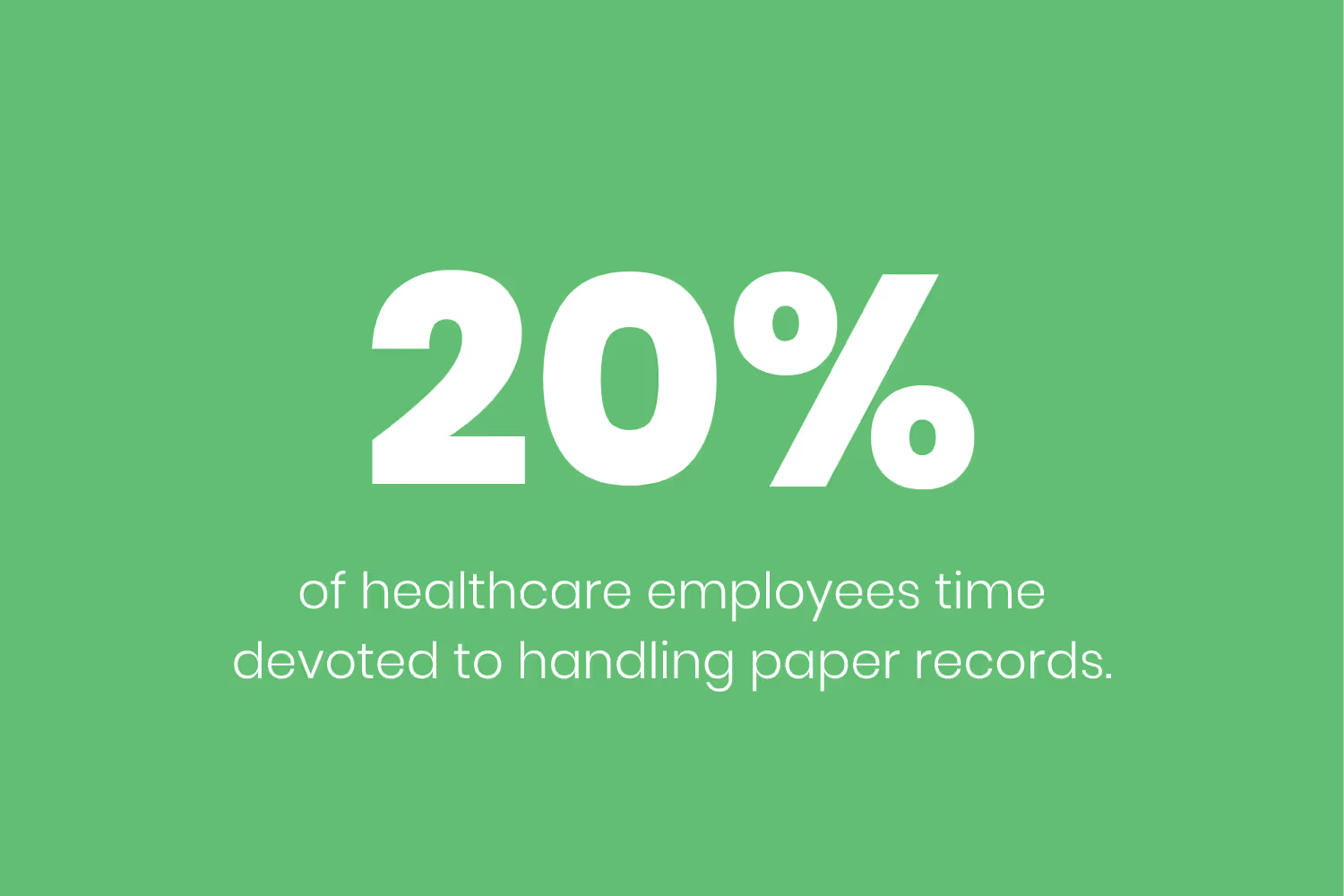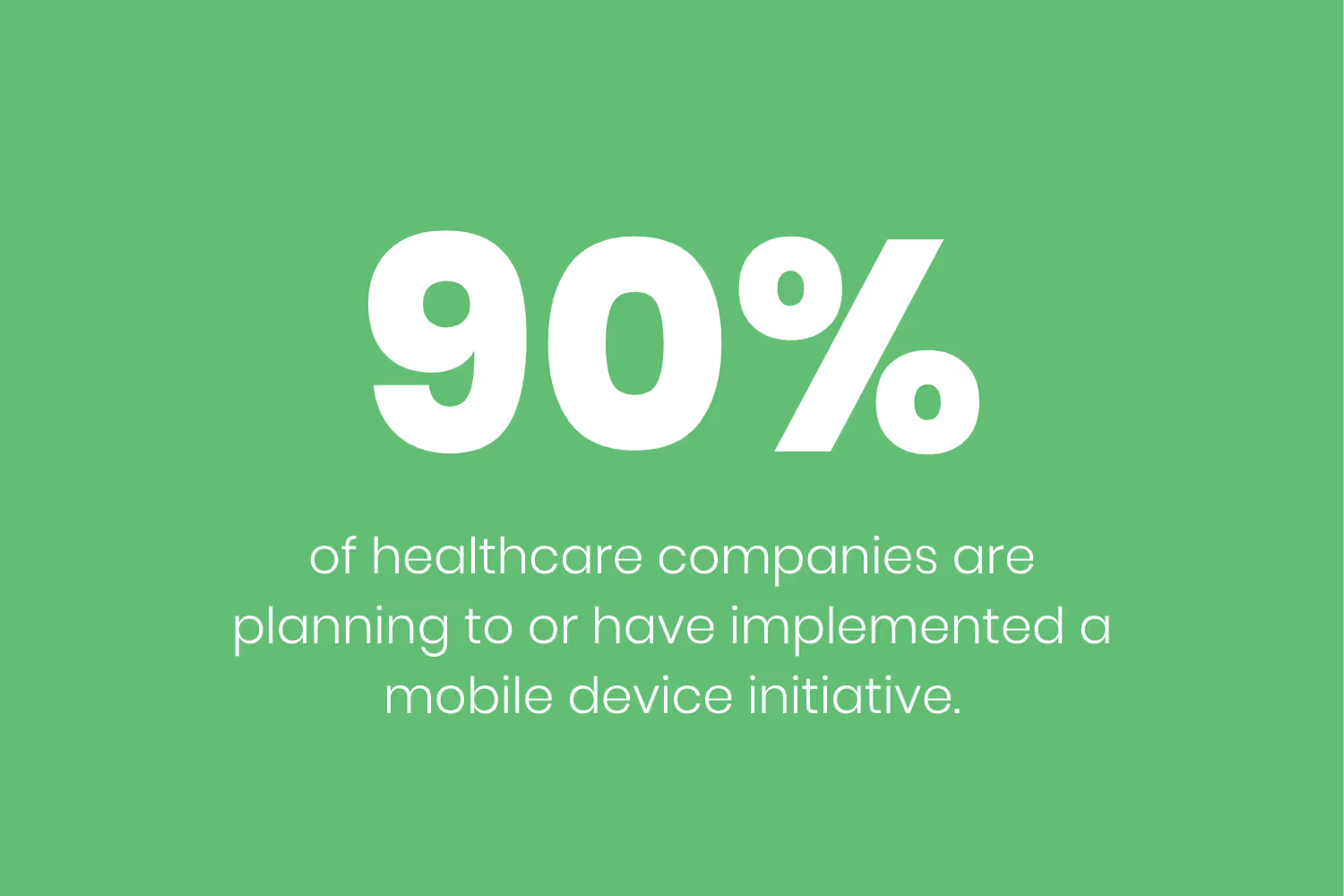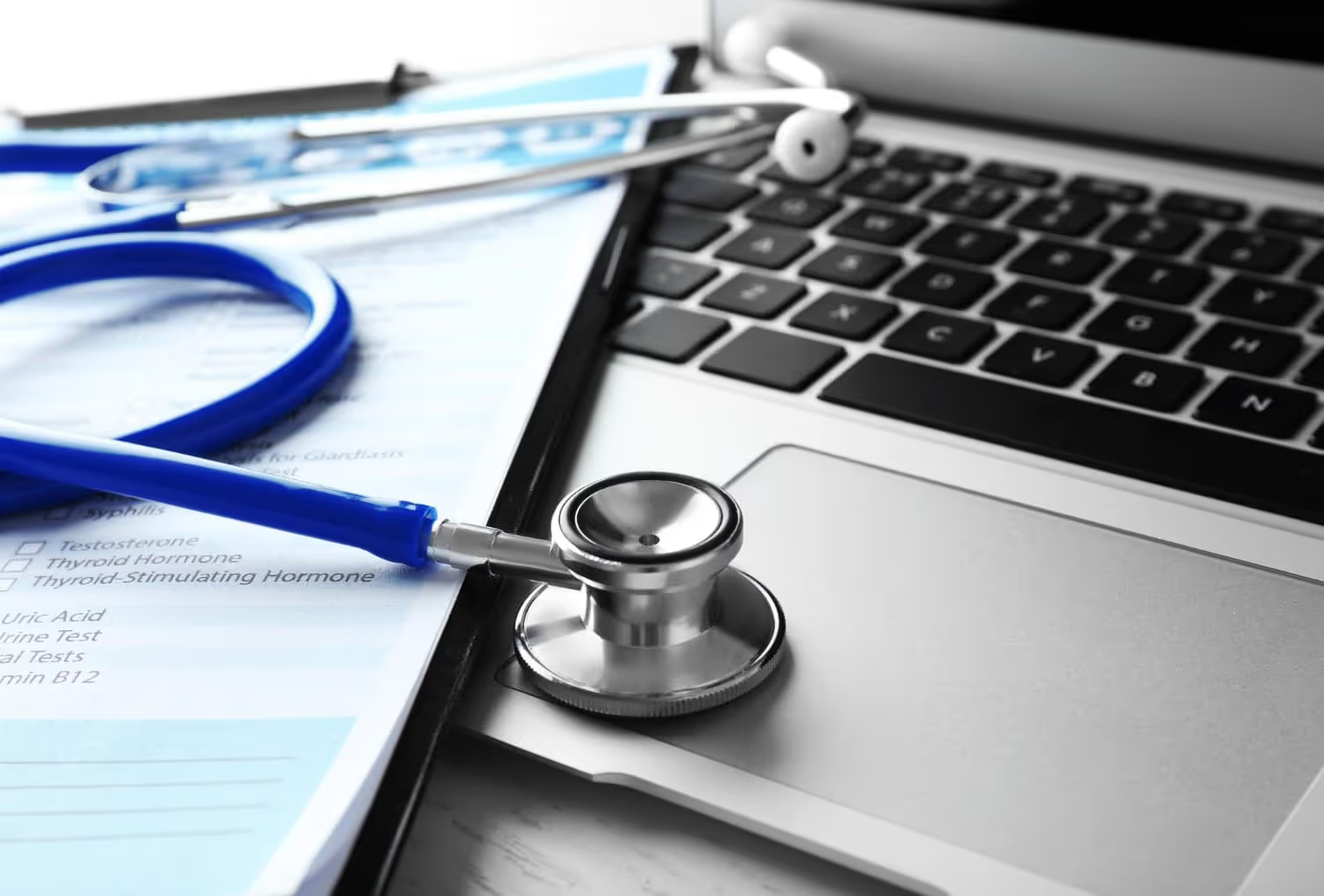Read All About It! Going Paperless in Healthcare
Going 100% paperless in healthcare is more complicated than it may seem. However, the benefits far outweigh the effort involved. Here’s our list of reasons why going paperless in healthcare is worth it.

Ten years ago, the thought of going completely paperless in healthcare would’ve made you chuckle. At that time, coming to your practice as a patient meant zoning out in the lobby while staring at endless rows of shelves stuffed with patient records until they heard their name called for an appointment.
One decade later and 86% of doctor’s offices use some form of electronic health record (EHR) system. Now when people visit your office it’s an entirely different experience. Those heaping piles of records are gone, which opens up the lobby. Some modern-day healthcare organizations even focus more on their interior design.
But switching to an EHR is only half the battle, there’s still more to it. Going 100% paperless in healthcare is more complicated than it may seem. However, the benefits far outweigh the effort involved.
Here’s our list of reasons why going paperless in healthcare is worth it.
Eliminates External Risks
Have you received a sales phone call from a managed service provider (MSP) or cybersecurity expert recently?
If you have, one of the questions they asked you was probably along the lines of, “Do you still use paper medical records?” If you’re using an EHR, you answered no. Was that the last question they asked you? If it was, they weren’t much of an expert in their field.
Instead, what they should’ve asked you is, “Do you still use paper at all at your practice?” This question is much harder for you to say no to. What kind of business doesn’t use any paper?
But the reality is that if you use paper as a healthcare organization, you’re putting a lot of sensitive information at risk. If you send the majority of your patients their statements through the mail and they accidentally get sent to the wrong addresses, that’s a HIPAA violation.

Imagine how embarrassing it would be to call each one of those patients and tell them that their most sensitive information went to someone neither of you has ever met.
Not only that but what if a tornado or other form of natural disaster comes through your practice’s town and hits your building? You’d come back to your office and find all your paper records scattered across your parking lot, damaged, or lost forever.
File Keeping, Sorting, and Searching
Having paper records is clunky beyond the risks associated with maintaining them. If you still have paper records, how long on average do you think it takes your employees to find the patient’s information that’s coming in for an appointment? If you want an exact number, it’s about 20% of their time.

As a doctor or other healthcare provider, you’re already bogged down as it is. Plus, you’ve more than likely seen the recent headlines about burnout within your industry.
Any time your employees can relieve some of the stresses of your job by taking on the more tedious task helps tremendously.
Imagine what they could help you with by having 20% more time throughout their day?
If your records are electronically stored, each of your employees would have access to them in one place. The best part is that finding a patient doesn’t require reciting the alphabet in your head and running your fingers over mildewed folders.
Finding any of your patients is only a search bar away.
Data Security and Safety
Let’s go over a quick scenario.
A front desk employee of yours goes out to lunch and forgets to put the file containing PHI on her desk back where it belongs. When they get back, the file is missing. This is a huge problem in two ways.
First, unless your office has security cameras facing the front desk there’s no way to figure out who took the file. Second, if the employee came back and forgot all about that file it wouldn’t get reported back to you. That’s a massive liability.
If you haven’t gone paperless in healthcare yet, the above scenario might be enough to persuade you to switch. If it hasn’t, you’re probably a little apprehensive at the thought of having your data accessible through the cloud.
After all, going completely paperless doesn’t mean you stop recording patient information, it all has to go somewhere.
You’re not in the minority, especially after reading about how hackers are increasingly going after healthcare organizations. But the reality is that paper records are the most common type of breach in hospitals while storing them electronically isn’t according to The American Journal of Managed Care.
There are risks with both ways of running your organization, but the pros of going paperless far outweigh its cons.
Increased Convenience Through Mobility
Using paper means you also have a lot of bent-up clipboards laying around the office.
While seeing a patient, if they have any questions you’ll either have to think hard about how to answer their question or bring a stack of diagrams to go through with them. Not to mention that it’s too risky to take your work home with you since losing it is so costly.
This is clunky.
But by going paperless you’re also encouraging the use of mobile devices such as phones or tablets at your office. Jumping on this trend places you on the innovative side of your industry.
90% of healthcare organizations are planning to or have already implemented a mobile device initiative.

This means that instead of having to prepare far ahead of time for an appointment, you can walk in with your device and be ready to go. With it, you’ll be able to access a patient’s record, show them charts and diagrams, communicate with other employees and even sign important documents with your client.
This also makes it possible for you to access important information from anywhere.
Instead of going into the office to look something up you can securely login through your phone and view whatever information you need to at a moment's notice. You may not even have to have your medical billers physically come into work anymore.
Environment-Friendly in The Eyes of Your Patients
There’s no questioning that people are more environment-conscious than they’ve ever been and they want to reward businesses that have similar beliefs.
This is especially true in younger generations.
In fact, 57% of Millennials say they’ll overlook products that aren’t eco-friendly. So it’s safe to say that this mentality also bleeds into the reasoning for choosing their doctor.
But does going paperless at your healthcare organization have a positive impact on the environment?
According to Paperless Productivity, one tree produces 17 reams (~8,500 sheets) of paper and 110 lbs of CO2. On average, the everyday office worker uses 10,000 sheets of paper every year.

With that number in mind, that’s almost 1.25 trees and 140 lbs of CO2 required per employee each year. Multiply that number by the number of employees you have and that’s how large your organization’s annual carbon footprint is from using paper.
If you’re a little worried right now, that’s okay. The moment you go paperless, your footprint disappears. This is something you can share as a part of your word of mouth marketing strategy to attract those younger patients to your practice.
Conclusion
The benefits of going paperless in healthcare stretch beyond having to control the clutter.
If, after reading this, you’re still apprehensive about making the switch, I have one final takeaway.
The majority of practices, hospitals, and other organizations in your industry made the switch already. So a lot of the vendors that will help you switch have already worked out a lot of issues that happened during their services’ early adopter phase.
Save yourself the headache, heartache and stress that could come from sticking with traditional techniques for running your practice and go paperless.
Emphasize your product's unique features or benefits to differentiate it from competitors
In nec dictum adipiscing pharetra enim etiam scelerisque dolor purus ipsum egestas cursus vulputate arcu egestas ut eu sed mollis consectetur mattis pharetra curabitur et maecenas in mattis fames consectetur ipsum quis risus mauris aliquam ornare nisl purus at ipsum nulla accumsan consectetur vestibulum suspendisse aliquam condimentum scelerisque lacinia pellentesque vestibulum condimentum turpis ligula pharetra dictum sapien facilisis sapien at sagittis et cursus congue.
- Pharetra curabitur et maecenas in mattis fames consectetur ipsum quis risus.
- Justo urna nisi auctor consequat consectetur dolor lectus blandit.
- Eget egestas volutpat lacinia vestibulum vitae mattis hendrerit.
- Ornare elit odio tellus orci bibendum dictum id sem congue enim amet diam.
Incorporate statistics or specific numbers to highlight the effectiveness or popularity of your offering
Convallis pellentesque ullamcorper sapien sed tristique fermentum proin amet quam tincidunt feugiat vitae neque quisque odio ut pellentesque ac mauris eget lectus. Pretium arcu turpis lacus sapien sit at eu sapien duis magna nunc nibh nam non ut nibh ultrices ultrices elementum egestas enim nisl sed cursus pellentesque sit dignissim enim euismod sit et convallis sed pelis viverra quam at nisl sit pharetra enim nisl nec vestibulum posuere in volutpat sed blandit neque risus.

Use time-sensitive language to encourage immediate action, such as "Limited Time Offer
Feugiat vitae neque quisque odio ut pellentesque ac mauris eget lectus. Pretium arcu turpis lacus sapien sit at eu sapien duis magna nunc nibh nam non ut nibh ultrices ultrices elementum egestas enim nisl sed cursus pellentesque sit dignissim enim euismod sit et convallis sed pelis viverra quam at nisl sit pharetra enim nisl nec vestibulum posuere in volutpat sed blandit neque risus.
- Pharetra curabitur et maecenas in mattis fames consectetur ipsum quis risus.
- Justo urna nisi auctor consequat consectetur dolor lectus blandit.
- Eget egestas volutpat lacinia vestibulum vitae mattis hendrerit.
- Ornare elit odio tellus orci bibendum dictum id sem congue enim amet diam.
Address customer pain points directly by showing how your product solves their problems
Feugiat vitae neque quisque odio ut pellentesque ac mauris eget lectus. Pretium arcu turpis lacus sapien sit at eu sapien duis magna nunc nibh nam non ut nibh ultrices ultrices elementum egestas enim nisl sed cursus pellentesque sit dignissim enim euismod sit et convallis sed pelis viverra quam at nisl sit pharetra enim nisl nec vestibulum posuere in volutpat sed blandit neque risus.
Vel etiam vel amet aenean eget in habitasse nunc duis tellus sem turpis risus aliquam ac volutpat tellus eu faucibus ullamcorper.
Tailor titles to your ideal customer segment using phrases like "Designed for Busy Professionals
Sed pretium id nibh id sit felis vitae volutpat volutpat adipiscing at sodales neque lectus mi phasellus commodo at elit suspendisse ornare faucibus lectus purus viverra in nec aliquet commodo et sed sed nisi tempor mi pellentesque arcu viverra pretium duis enim vulputate dignissim etiam ultrices vitae neque urna proin nibh diam turpis augue lacus.



![[ANSWERED] What is a Long-Term Care (LTC) Pharmacy](https://cdn.prod.website-files.com/67e2b8210878abcba6f91ae6/68d687806a075a1cf64659b0_WhatisLongTermCarePharmacy_925.avif)
